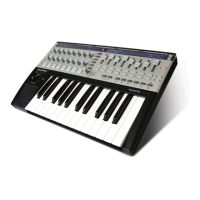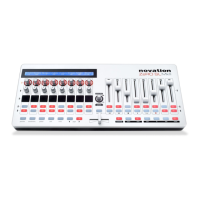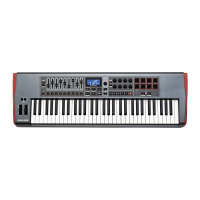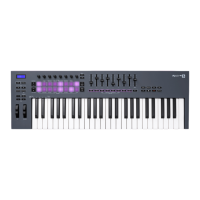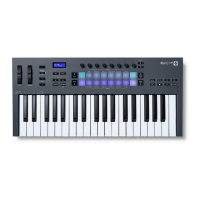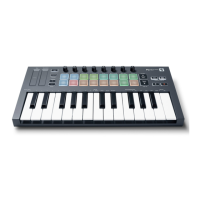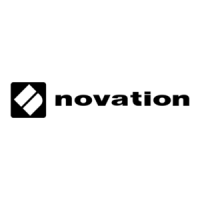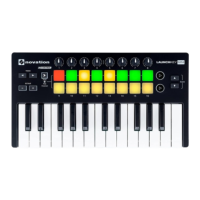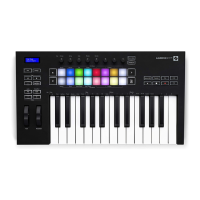Do you have a question about the Novation SL MkII and is the answer not in the manual?
Details 8 touch-sensitive rotary encoders, 8 pots, 8 sliders, 32 buttons, 6 transport buttons, 8 drum pads.
Describes fixed-function controls like LCD display, Automap buttons, Page buttons, Row-Select, Mode/System, Octave, Speed Dial, and Keyboard.
Details power input, USB, sustain/expression pedal sockets, and MIDI ports (out, thru, in).
Explains how to adjust the spring tension of the pitch/mod joystick.
Describes the SL MkII's automatic calibration of touch-sensitive controls on startup.
Connects the SL MkII to a computer via USB for music software control.
Connects the SL MkII to external MIDI hardware using a PSU and MIDI cable.
Details using the SL MkII to control both software and hardware simultaneously.
Describes Automap Mode, requiring the Automap Server application and USB connection.
Describes Advanced Mode for controlling hardware or software without Automap.
Explains how to activate Automap Mode by pressing the 'automap' button.
Explains the function of system buttons like Learn, View, User, FX, Inst, Mixer.
Describes the unique default template used in Automap Mode.
Explains the two functions of the Speed Dial knob: mouse control and preset selection.
Details Port 1 usage for keyboard, pedals, and general MIDI messages.
Details Port 2 usage, often for special templates or complex setups.
Describes the hidden Automap port used for Automap Server communication.
Details setup for specific DAWs using Port 1, Port 2, and Automap Port.
Details setup for other DAWs using Automap HUI.
Details setup for general software using Automap MIDI CC.
Refers to Advanced Mode for details on special templates for Ableton Live and Reason.
Explains how to switch between the 32 pre-built Advanced Mode templates.
Explains that templates are saved layouts of controls for sending MIDI data.
Describes the Speed Dial's functions: controlling on-screen parameters and displaying templates.
Details sending MIDI data to hardware via MIDI ports and software via USB ports.
Notes on using Ableton templates with VST/AU plugins and switching modes.
Notes on using Reason templates with Port 2 and controlling Reason features.
Details how to save current settings and templates using the 'Write' button.
Outlines the three levels of settings: individual controls, template, and global.
Use to output a bank change message from the template Keyboard Port.
Use to output a program change message from the template Keyboard Port.
Transposes the keyboard up and down in semitone steps.
Use to change the current Tempo, with additional options in the Tempo submenu.
Explains Template Edit Mode and Control Edit Mode for template customization.
Covers Velocity Curve, AfterTouch, and Pot Pick-up settings for templates.
Options to edit zone parameters like Low/High Note, Transpose, VelCurve, MidiChan, Ports.
Options for AfterTouch, Expression Pedal, Sustain Pedal, Pitch Bend, Modwheel per zone.
Sets whether control messages are included in keyboard zones or follow template/zone settings.
Defines MIDI channel and port routing for Keyboard and Common controls.
Allows grouping multiple templates together and setting their position and size.
Contains global settings like Memory Protect, Pot Pick-Up, Display Timeout, Keep Values, Touch Select.
Sets transport button behavior globally or per template.
Configures the polarity of the sustain pedal.
Contains options for boot-up mode, default template, and automatic demonstration.
Configures MIDI routing for USB and MIDI ports, including clock and program changes.
Sets the source for MIDI Clock input (AUTO, INTERNAL, EXT-AUTO).
Controls sending ReWire BPM messages for tempo sync when Automap is running.
Configures MIDI channel and port for receiving program changes to switch templates.
Allows dumping templates (single or all) to a computer or MIDI device for backup.
Covers dumping templates/globals and OS updates via MIDI/USB.
Guides through calibrating drum pad velocity and sensitivity.
Details how to calibrate the pitch/mod joystick's range and center points.
Guides through aftertouch and keyboard size calibration processes.
Covers saving global settings and using transport buttons.
Table showing which MIDI messages can be assigned to physical controls.
Details the Control Change (CC) MIDI message type and its settings.
Sets how CC values are displayed (e.g., 0-127, -64/+63) and encoder modes.
Specific settings for encoders like REL1, REL2, 0-16K, and APOT.
Options for unassigned controls, including assigning a LABEL or setting a VALUE RANGE.
Specific settings for buttons like DispType, LED, and BtnType.
General settings for control editing including Ports, KeybPORT, and ComnPORT.
Covers MidiChan, CC Num, and Pick-Up response settings for controls.
Describes XY pad operation and selecting axes for editing.
Covers XY Pad modes, NRPN LSB/MSB, and RPN LSB/MSB settings.
Covers SYSEX DispType, Length, DataType, and Data Position settings.
Sets the MMC command type and Device ID for transport control.
Details configuration for Note, Bank Change, and Program Change messages.
Configures Auto-Off and Off Sync timing for drum pad note messages.
Details 8 touch-sensitive rotary encoders, 8 pots, 8 sliders, 32 buttons, 6 transport buttons, 8 drum pads.
Describes fixed-function controls like LCD display, Automap buttons, Page buttons, Row-Select, Mode/System, Octave, Speed Dial, and Keyboard.
Details power input, USB, sustain/expression pedal sockets, and MIDI ports (out, thru, in).
Explains how to adjust the spring tension of the pitch/mod joystick.
Describes the SL MkII's automatic calibration of touch-sensitive controls on startup.
Connects the SL MkII to a computer via USB for music software control.
Connects the SL MkII to external MIDI hardware using a PSU and MIDI cable.
Details using the SL MkII to control both software and hardware simultaneously.
Describes Automap Mode, requiring the Automap Server application and USB connection.
Describes Advanced Mode for controlling hardware or software without Automap.
Explains how to activate Automap Mode by pressing the 'automap' button.
Explains the function of system buttons like Learn, View, User, FX, Inst, Mixer.
Describes the unique default template used in Automap Mode.
Explains the two functions of the Speed Dial knob: mouse control and preset selection.
Details Port 1 usage for keyboard, pedals, and general MIDI messages.
Details Port 2 usage, often for special templates or complex setups.
Describes the hidden Automap port used for Automap Server communication.
Details setup for specific DAWs using Port 1, Port 2, and Automap Port.
Details setup for other DAWs using Automap HUI.
Details setup for general software using Automap MIDI CC.
Refers to Advanced Mode for details on special templates for Ableton Live and Reason.
Explains how to switch between the 32 pre-built Advanced Mode templates.
Explains that templates are saved layouts of controls for sending MIDI data.
Describes the Speed Dial's functions: controlling on-screen parameters and displaying templates.
Details sending MIDI data to hardware via MIDI ports and software via USB ports.
Notes on using Ableton templates with VST/AU plugins and switching modes.
Notes on using Reason templates with Port 2 and controlling Reason features.
Details how to save current settings and templates using the 'Write' button.
Outlines the three levels of settings: individual controls, template, and global.
Use to output a bank change message from the template Keyboard Port.
Use to output a program change message from the template Keyboard Port.
Transposes the keyboard up and down in semitone steps.
Use to change the current Tempo, with additional options in the Tempo submenu.
Explains Template Edit Mode and Control Edit Mode for template customization.
Covers Velocity Curve, AfterTouch, and Pot Pick-up settings for templates.
Options to edit zone parameters like Low/High Note, Transpose, VelCurve, MidiChan, Ports.
Options for AfterTouch, Expression Pedal, Sustain Pedal, Pitch Bend, Modwheel per zone.
Sets whether control messages are included in keyboard zones or follow template/zone settings.
Defines MIDI channel and port routing for Keyboard and Common controls.
Allows grouping multiple templates together and setting their position and size.
Contains global settings like Memory Protect, Pot Pick-Up, Display Timeout, Keep Values, Touch Select.
Sets transport button behavior globally or per template.
Configures the polarity of the sustain pedal.
Contains options for boot-up mode, default template, and automatic demonstration.
Configures MIDI routing for USB and MIDI ports, including clock and program changes.
Sets the source for MIDI Clock input (AUTO, INTERNAL, EXT-AUTO).
Controls sending ReWire BPM messages for tempo sync when Automap is running.
Configures MIDI channel and port for receiving program changes to switch templates.
Allows dumping templates (single or all) to a computer or MIDI device for backup.
Covers dumping templates/globals and OS updates via MIDI/USB.
Guides through calibrating drum pad velocity and sensitivity.
Details how to calibrate the pitch/mod joystick's range and center points.
Guides through aftertouch and keyboard size calibration processes.
Covers saving global settings and using transport buttons.
Table showing which MIDI messages can be assigned to physical controls.
Details the Control Change (CC) MIDI message type and its settings.
Sets how CC values are displayed (e.g., 0-127, -64/+63) and encoder modes.
Specific settings for encoders like REL1, REL2, 0-16K, and APOT.
Options for unassigned controls, including assigning a LABEL or setting a VALUE RANGE.
Specific settings for buttons like DispType, LED, and BtnType.
General settings for control editing including Ports, KeybPORT, and ComnPORT.
Covers MidiChan, CC Num, and Pick-Up response settings for controls.
Describes XY pad operation and selecting axes for editing.
Covers XY Pad modes, NRPN LSB/MSB, and RPN LSB/MSB settings.
Covers SYSEX DispType, Length, DataType, and Data Position settings.
Sets the MMC command type and Device ID for transport control.
Details configuration for Note, Bank Change, and Program Change messages.
Configures Auto-Off and Off Sync timing for drum pad note messages.
| Aftertouch | Yes |
|---|---|
| Type | MIDI Controller Keyboard |
| Keys | 49 |
| Encoders | 8 |
| Connectivity | USB, MIDI In, MIDI Out |
| Power | USB |
| Software | Automap software |
| Display | Backlit LCD screens |
| DAW Integration | Automap software for DAW control |
| Dimensions | Varies by model |
| Weight | Varies by model |
| Faders | 8 (25-key) |
